FEMI OYEBODE TRAVELS TO THE DEEP SOUTH OF THE US TO TAKE IN SOME GREAT MUSIC IN NEW ORLEANS AND BEYOND.
Congo Square. Just north of the French Quarter in New Orleans, on the other side of Rampart Street, within the Louis Armstrong Park, in the Trème district, is this sacred space that the American Indians had used for centuries for their religious gatherings but taken over by Africans on Sundays during slavery.
It remains hallowed ground. A space where Africans had reimagined Africa, dancing the Bamboulas and singing on Sundays, consecrated for the old gods. You could say that all the music and dances invented in America were born here: Jazz, the Blues and its later derivatives Rock ‘N Rock, Country, Soul, etc. A relief statue by Wale Adenle imagines it as a Yoruba plaza but it is more likely to have been Bakongo, from central Africa, fed and nourished by the great Congo River, the richness of the tropical forest, the abundant energies of Africa. What Conrad construed as the “Heart of Darkness”.
We are spending a week travelling through Louisiana & Tennessee to sample the variety of American music. Last night, at Snug Harbour, Frenchmen Street, New Orleans, we heard Dr Michael White and his band which included Jason Marsalis on drums, Ms Watanabe on piano and Williams on cornet/trumpet.
White’s rendition of George Lewis’ Burgundy Street Blues was extraordinary, slow, moving and beautiful. Then his interpretation of Gershwin’s Summertime matched the earlier Lewis. This was New Orleans’ style at its best, taking a song and re-working it, making it something new and fresh, something original yet familiar. Dr White plays jazz clarinet to convert the faithless to prayer.
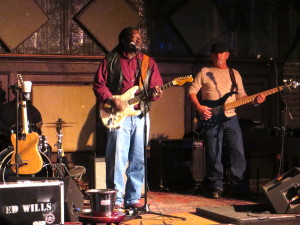 Ed Wills plays electric blues next door. Between the best jazz and this bittersweet music, you heard everything that could not be uttered in words: the deep seated and strangled potency. When you went outside into the cold evening and saw the hobos sitting by doorways, and you looked into the eyes of black men who studiously avoided yours, you knew what ailed them, what impossible dreams had been battened down and turned into song.
Ed Wills plays electric blues next door. Between the best jazz and this bittersweet music, you heard everything that could not be uttered in words: the deep seated and strangled potency. When you went outside into the cold evening and saw the hobos sitting by doorways, and you looked into the eyes of black men who studiously avoided yours, you knew what ailed them, what impossible dreams had been battened down and turned into song.
We walked back slowly through the French Quarter and ended up in the last half hour of the Jazz Preservation Hall. Will Smith was the leader and he sang in the Armstrong style, each word clearly enunciated, storytelling in song. New Orleans clings to the early 20th century. Sidney Bechet, George Lewis, Jelly Roll Morton, Chris Bolden, Louis Armstrong.
These towering figures whose musical imagination dominated jazz, set down the standards, looking far into the future knowing that their reputations would outlive whatever calumny or contempt they’d borne.
We are staying at the Country Inn & Suites by Carlson on Magazine Street just off Canal Street in the French Quarter.
Bourbon Street is just 5 minutes away.
I took an ambling walk through Bourbon Street at midday. It was still recovering from the last evening like a perpetual drunk with a hangover, struggling to walk upright. Many bars were cleansing the pavements outside their establishments with spurts of water from hosepipes. There were neon lights up and down the street. At night these lights, alluring and seductive, rendered the street a place of fantasy and illusions.
Down one side the Hustler establishments read “it’s just sex, relax” and then the various bars and Big Daddy’s Sex Acts pushed the limits of what is permissible, what is “Barely Legal”.
It was mostly tourists with cameras, groups of young men, couples, some friends and families, stopping by street signs and posing for memorable images of their brush with iniquity. At night, the atmosphere is different, throbbing with energy and desire, lustful desire, and the barely concealed seeking for thrills. But, the music, the jazz or blues floating or bursting out of the bars, is genuine. It is the language that Africa has chosen to speak in the New World. Even when it is full of anguish, when you hear a cry in the throat of the trumpet or saxophone, there is always present the irrepressible and haunting exhilaration of Africa.
Frenchmen Street is at the end of town. What it lacks in the frisson of Bourbon Street it makes up for the in sheer luxury and variety of its music bars. Riches that are incalculable. A tangle of vine and more vine, lianas that smoke-like ascend into the sky, delicate tendrils of pleasure. A delirious and provocative fever without germ, but that proceeds from a clamor in the heart. Delicious. It ends I suppose like an orgasm, ecstatic triumph followed by restful sleep.
Nashville is very different from New Orleans. Think of the old world, narrow streets, wrought iron balustrades, verandas, and the easy life and you have the French quarter. Here in Nashville the Broadway is broad and cuts a swathe heading downtown. And downtown was a collection of run down buildings facing the street. This was “The District”. Nothing picturesque here. The music too lacked the grit in the eye of blues or jazz. Anodyne. And, insular.
We are staying at the Union Station, a glorious building celebrating the railway, now a boutique hotel. The hallway is an outrageous vault of the most exquisite gold. A cathedral of arches, of gold leaf, of copper balustrades, stained glass and mahogany stairway. What’s missing is the organ and the pews. From outside, the station is a German castle in grey stone, turrets and all. You can ignore whatever else I have to say about Nashville, the Union Station makes up for the deficiencies, the absence of old world charm, the importunate and intemperate weather.
We traveled from Nashville to Memphis by Greyhound. It was a bitterly cold day. The threat of snow hung in the sky all the way. We stopped for 15 minutes at Jackson , Tennessee to drop off some people and pick up others. The terminus had the appearance of a long forgotten place built in the 50s and painted Navy blue, never given another licking of paint, ever. It reminded me of the old Lagos airport, except that was painted a job lot of off white, somewhere between cream and dirty.
At Nashville, the terminus was modern but the clientele were a rare specie composed of young white university types going home for Thanksgiving and black families, obviously travelling as cheaply as possible. One woman dramatizing her predicament: I’ve worked all night and missed the bus and had to pay a penalty of $20. Everyone commiserated with her.
The highlight of the Nashville terminus was the Amish families. Dressed in black, the women with headscarves and bonnet from the Victorian era, black functional boots, no make-up. There were elderly and young women, also children and babies. The men wore black trousers with wide plain fronts, blue waistcoats and blue jackets, rounded at the shoulders. Their beards were long and biblical, elders or judges. One seemed inclined to talk and the others to congregate together. The children did not seem to be drawn to watch the tv monitors. They seemed strangely unfazed by the glaring modernity all about them. But once the bus was on the move, one girl stood up to watch the countryside pass by, entranced by the autumnal colors, the infinite variation of red, yellow, brown, and ochre.
When we arrived in Memphis, we took a taxi to our hotel, Peabody Hotel, famous for the display of ducks that came down and back up the lifts twice daily. Checked in and then went straight to BB King’s Blues Club for a lunch of catfish, chicken wings, pickles and French fries.
Delicious.
We were on Beale Street. Our first night at Beale Street was a revelation. In the evening we started out at Rum Boogie Cafe. Brandon Santini was playing. A maestro of the harmonica. He crouched and whipped out the most astonishing sounds of death and anguish. He blew his guts out, literally. We had never seen a spectacle quite like it. These instruments cried, wailed, moaned, tortured and orgasmic, ecstatic and mournful. We had intended to go from bar to bar but with a performance like this we were glued to our seats. A glass of Shiraz in hand, ears all attentive, the spirit alive to every nuance of the music, we sat upright and astonished in our seats.
A jazz band from Nashville visiting Memphis for the first time played two numbers. The lead man also played the harmonica. A different style altogether. He growled, gruff sounds of the utmost intimacy. He sang and sang, an angel of death and then of hope, redemption and poison laced in his tone. His body contorted and relaxed. I hadn’t realized that the Blues are the epicenter of darkness.
Then an Israeli group played two numbers joined by Santini. The vocalist, a thin, wiry girl with long dark hair, long etiolated arms that she waved and thrashed about in the air, sang in a rough voice. These were the Blues, born in Memphis, distilled by the harshest injustices of slavery and poverty, dipped in blood and then vented slowly, rashly, violently, volcanic and furious in the voice. Always African in elegance and stature.
There’s only so much of this saddest of sounds that you can take in one sitting. We stood up and went back to BB King’s place.
The King Beez was playing Soul. A young, dark chocolate, girl and a light skinned woman sang and danced. What is it about sex that speaks through dance? Is it the movement of limbs, graceful and synchronous? Or, is it that the head thrown backwards with abandon suggests an inner uncontrollable thrill that in spasms pulls and electrifies what ought to be sedate? Eyes shut or open, mouth slightly agape. A smile that spreads like light at dawn from the edges of the mouth, the chest pushed forward, breathless, breathless. The music was pulsing and the harmonies flowing, coursing through the blood.
This was not the Blues, not jazz, not despair, not anger, but joy and the surprise of an orgasm when it lights up a weary and deadened body.
Soon, we went to bed.
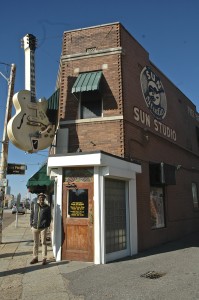 Graceland. An early morning start. A mansion with several acres. Not much to my taste. The story of rags to riches an enduring motif of American life. The remarkable achievement of one individual spirit, irrepressible, singing and moving others. The Sun records studio showed the connections between black music and Elvis. Howlin’ Wolf, Ike Turner, BB King, the long list of exponents of the art of transmuting suffering into song. Then the Rock and Soul Museum. The back catalogue of Stax Records: Isaac Hayes, Ann Peebles, Al Green, Staple Singers, Rufus Thomas, Bar-Keys, Mar-Keys, and the Memphis Horns.
Graceland. An early morning start. A mansion with several acres. Not much to my taste. The story of rags to riches an enduring motif of American life. The remarkable achievement of one individual spirit, irrepressible, singing and moving others. The Sun records studio showed the connections between black music and Elvis. Howlin’ Wolf, Ike Turner, BB King, the long list of exponents of the art of transmuting suffering into song. Then the Rock and Soul Museum. The back catalogue of Stax Records: Isaac Hayes, Ann Peebles, Al Green, Staple Singers, Rufus Thomas, Bar-Keys, Mar-Keys, and the Memphis Horns.
Once you knew the source of the music, a greater appreciation of the achievements came to mind. Ali Farka Toure once said we have given them [Black Americans] the stem, the branches and leaves but kept the roots for ourselves. But, what incredible flourishing they have made of these. What glorious colors, what flowering, what sheer delight?
The next night we went back to BB King’s place.
Bryan Lake was playing the most outrageous, most exquisite guitar. What could he not do? What devil incarnated his instrument with a fever, a rising delirious miasma from the roundabout swamps? An ague of the soul that sang and quaked through him? Yet, he was intact at the end, not fractured or moribund, a young, lithe White American playing as if he’d been abducted from the Nigerian Plateau, taken from Africa, stowed sardine-like in slave galleys, beaten and sold ten times over in Tennessee, soaked in mud and sweat, degraded and despised yet alive and celebrating life.
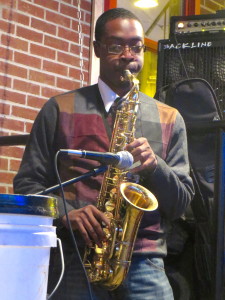 Mr Shannon at the Blues Cafe, played a Blues that was soothing. Blues that you danced to. The night before at WC Handy’s cafe we heard a trio, the young saxophonist barely 17 years of age. He played a Groover Washington number from the 70s, when I was a young man. I’d heard Washington play it live in Philadelphia in 1981.
Mr Shannon at the Blues Cafe, played a Blues that was soothing. Blues that you danced to. The night before at WC Handy’s cafe we heard a trio, the young saxophonist barely 17 years of age. He played a Groover Washington number from the 70s, when I was a young man. I’d heard Washington play it live in Philadelphia in 1981.
The following day we saw this young man, on the street, with his music case and stopped to talk to him. I complimented him on his Groover Washington. He was astonished and said he hadn’t thought anyone would know the number. Now, that is music for you, composed and played by a black American, heard in Ibadan by an African youth, played again by a black American kid 30’years on and heard by an ageing African, naturalized Briton in Memphis. What goes round comes round!
Last night in New Orleans was a dish of Maison Bourbon Jazz Club spiced in Jamal Sharif, cooked slowly at Spotted Cat with an ensemble of Shotgun Jazz as of the “shotgun cabins”, marinaded in Bamboulas Jazz Vipers and finally preserved at Jazz Preservation Hall by Will Smith and colleagues. This was a fine end to our musical trip of the South.
Congo Square!
Photos by Jan Oyebode
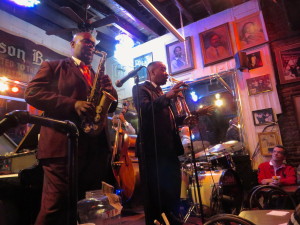
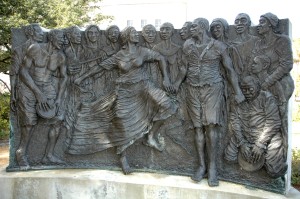
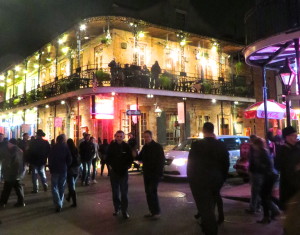
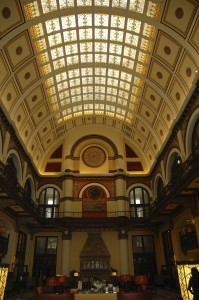



Nice to read a piece from someone who loves music and travelled to hear it. I loved the pictures too